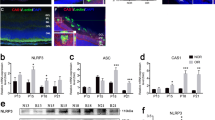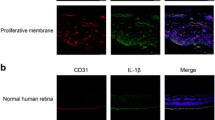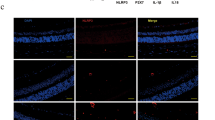Abstract
UV-B stimulation can induce retinopathy, whose pathogenesis is currently unclear. UV-B mediated inflammation in retinal endothelial cells is reported to be involved in the pathogenesis of retinopathy. S14G-humanin (HNG) is a neuroprotective peptide that has recently been reported to exert significant anti-inflammatory effects and protective properties against cell death. The present study aims to investigate the protective effects of HNG against UV-B-challenged retinal endothelial cells and explore the underlying mechanism. UV-B radiation was used to induce an injury model in human retinal endothelial cells (HRECs). First, exposure to UV-B induced the expression of TXNIP. Additionally, we found that treatment with HNG inhibited the activation of the TXNIP/NLRP3 signaling pathway and mitigated the excessive release of IL-1β and IL-18 in UV-B-challenged HRECs. UV-B increased the expression of the transcriptional factor endothelial growth response-1 (Egr-1). Interestingly, overexpression of Egr-1 increased the luciferase activity of the TXNIP promoter as well as the mRNA and protein expression of TXNIP. In contrast, the knockdown of Egr-1 reduced the expression of TXNIP under both the normal and UV-B exposure conditions. Importantly, treatment with HNG attenuated UV-B-induced expression of Egr-1. However, overexpression of Egr-1 abolished the inhibitory effects of HNG-induced activation of NLRP3 as well as the production of IL-1β and IL-18. Taken together, our findings reveal that HNG protected retinal endothelial cells from UV-B-induced NLRP3 inflammation activation through inhibiting TXNIP mediated by Egr-1.








Similar content being viewed by others
Data available statement
Data are available at a reasonable request to the corresponding author.
References
Mohania D, Chandel S, Kumar P, Verma V, Digvijay K, Tripathi D, Choudhury K, Mitten SK, Shah D. Ultraviolet radiations: skin defense-damage mechanism. Adv Exp Med Biol. 2017;996:71–87.
Tratsk KS, Thanos S. UV irradiation causes multiple cellular changes in cultured human retinal pigment epithelium cells. Graefes Arch Clin Exp Ophthalmol. 2003;241(10):852–9.
Norval M, Lucas RM, Cullen AP, de Gruijl FR, Longstreth J, Takizawa Y, van der Leun JC. The human health effects of ozone depletion and interactions with climate change. Photochem Photobiol Sci. 2011;10(2):199–225.
Steinle JJ. Retinal endothelial cell apoptosis. Apoptosis. 2012;17(12):1258–60.
Lin H, Yue Y, Maidana DE, Bouzika P, Atik A, Matsumoto H, Miller JW, Vavvas DG. Drug delivery nanoparticles: toxicity comparison in retinal pigment epithelium and retinal vascular endothelial cells. Semin Ophthalmol. 2016;31(1–2):1–9.
Dagher Z, Park YS, Asnaghi V, Hoehn T, Gerhardinger C, Lorenzi M. Studies of rat and human retinas predict a role for the polyol pathway in human diabetic retinopathy. Diabetes. 2004;53(9):2404–11.
Stitt AW, McGoldrick C, Rice-McCaldin A, McCance DR, Glenn JV, Hsu DK, Liu FT, Thorpe SR, Gardiner TA. Impaired retinal angiogenesis in diabetes: role of advanced glycation end products and galectin-3. Diabetes. 2005;54(3):785–94.
Guo Y, Gu R, Gan D, Hu F, Li G, Xu G. Mitochondrial DNA drives noncanonical inflammation activation via cGAS-STING signaling pathway in retinal microvascular endothelial cells. Cell Commun Signal. 2020;18(1):172.
Sun X, Jiao X, Ma Y, Liu Y, Zhang L, He Y, Chen Y. Trimethylamine N-oxide induces inflammation and endothelial dysfunction in human umbilical vein endothelial cells via activating ROS-TXNIP-NLRP3 inflammasome. Biochem Biophys Res Commun. 2016;481(1–2):63–70.
Wang X, Jiang M, He X, Zhang B, Peng W, Guo L. N-acetyl cysteine inhibits the lipopolysaccharide-induced inflammatory response in bone marrow mesenchymal stem cells by suppressing the TXNIP/NLRP3/IL1beta signaling pathway. Mol Med Rep. 2020;22(4):3299–306.
Chen W, Zhao M, Zhao S, Lu Q, Ni L, Zou C, Lu L, Xu X, Guan H, Zheng Z, Qiu Q. Activation of the TXNIP/NLRP3 inflammasome pathway contributes to inflammation in diabetic retinopathy: a novel inhibitory effect of minocycline. Inflamm Res. 2017;66(2):157–66.
Hanamsagar R, Torres V, Kielian T. Inflammasome activation and IL-1beta/IL-18 processing are influenced by distinct pathways in microglia. J Neurochem. 2011;119(4):736–48.
Lammerding L, Slowik A, Johann S, Beyer C, Zendedel A. Poststroke inflammasome expression and regulation in the peri-infarct area by gonadal steroids after transient focal ischemia in the rat brain. Neuroendocrinology. 2016;103(5):460–75.
Nagyoszi P, Nyul-Toth A, Fazakas C, Wilhelm I, Kozma M, Molnar J, Hasko J, Krizbai IA. Regulation of NOD-like receptors and inflammasome activation in cerebral endothelial cells. J Neurochem. 2015;135(3):551–64.
Hoeve AL, Hakimi HA, Barragan A. Sustained Egr-1 response via p38 MAP kinase signaling modulates early immune responses of dendritic cells parasitized by Toxoplasma gondii. Front Cell Infect Microbiol. 2019;9:349.
Sarkar R, Verma SC. Egr-1 regulates RTA transcription through a cooperative involvement of transcriptional regulators. Oncotarget. 2017;8(53):91425–44.
Gashler A, Sukhatme VP. Early growth response protein 1 (Egr-1): Prototype of a zinc-finger family of transcription factors. Prog Nucleic Acid Res Mol Biol. 1995;50:191–224.
MacDonald M, Barbat-Artigas S, Cho C, Peng H, Shang J, Moustaine A, Carbonetto S, Robitaille R, Chalifour LE, Paudel H. A Novel Egr-1-agrin pathway and potential implications for regulation of synaptic physiology and homeostasis at the neuromuscular junction. Front Aging Neurosci. 2017;9:258.
Chuang K, Chen FW, Tsai MH, Shieh JJ. EGR-1 plays a protective role in AMPK inhibitor compound C-induced apoptosis through ROS-induced ERK activation in skin cancer cells. Oncol Lett. 2021;21(4):304.
Nishimoto I, Matsuoka M, Niikura T. Unravelling the role of Humanin. Trends Mol Med. 2004;10(3):102–5.
Niikura T, Chiba T, Aiso S, Matsuoka M, Nishimoto I. Humanin: after the discovery. Mol Neurobiol. 2004;30(3):327–40.
Jung SS, Van Nostrand WE. Humanin rescues human cerebrovascular smooth muscle cells from Abeta-induced toxicity. J Neurochem. 2003;84(2):266–72.
Miao J, Zhang W, Yin R, Liu R, Su C, Lei G, Li Z. S14G-Humanin ameliorates Abeta25-35-induced behavioral deficits by reducing neuroinflammatory responses and apoptosis in mice. Neuropeptides. 2008;42(5–6):557–67.
Shiroto Y, Terashima S, Hosokawa Y, Oka K, Isokawa K, Tsuruga E. The effect of ultraviolet B on fibrillin-1 and fibrillin-2 in human non-pigmented ciliary epithelial cells In Vitro. Acta Histochem Cytochem. 2017;50(3):105–9.
Schroder K, Tschopp J. The inflammasomes. Cell. 2010;140(6):821–32.
Ye X, Zuo D, Yu L, Zhang L, Tang J, Cui C, Bao L, Zan K, Zhang Z, Yang X, Chen H, Tang H, Zu J, Shi H, Cui G. ROS/TXNIP pathway contributes to thrombin induced NLRP3 inflammasome activation and cell apoptosis in microglia. Biochem Biophys Res Commun. 2017;485(2):499–505.
Spindel ON, World C, Berk BC. Thioredoxin interacting protein: redox dependent and independent regulatory mechanisms. Antioxid Redox Signal 2012;16 (6):587-96
Yin Y, Zhou Z, Liu W, Chang Q, Sun G, Dai Y. Vascular endothelial cells senescence is associated with NOD-like receptor family pyrin domain-containing 3 (NLRP3) inflammasome activation via reactive oxygen species (ROS)/thioredoxin-interacting protein (TXNIP) pathway. Int J Biochem Cell Biol. 2017;84:22–34.
Wang XX, Cheng Q, Zhang SN, Qian HY, Wu JX, Tian H, Pei DS, Zheng JN. PAK5-Egr1-MMP2 signaling controls the migration and invasion in breast cancer cell. Tumour Biol. 2013;34(5):2721–9.
Wang NP, Pang XF, Zhang LH, Tootle S, Harmouche S, Zhao ZQ. Attenuation of inflammatory response and reduction in infarct size by postconditioning are associated with downregulation of early growth response 1 during reperfusion in rat heart. Shock. 2014;41(4):346–54.
Veyrac A, Gros A, Bruel-Jungerman E, Rochefort C, Kleine Borgmann FB, Jessberger S, Laroche S. Zif268/egr1 gene controls the selection, maturation and functional integration of adult hippocampal newborn neurons by learning. Proc Natl Acad Sci U S A. 2013;110(17):7062–7.
Saben J, Zhong Y, Gomez-Acevedo H, Thakali KM, Borengasser SJ, Andres A, Shankar K. Early growth response protein-1 mediates lipotoxicity-associated placental inflammation: role in maternal obesity. Am J Physiol Endocrinol Metab. 2013;305(1):E1-14.
McCaffrey TA, Fu C, Du B, Eksinar S, Kent KC, Bush H, Jr. Kreiger K, Rosengart T, Cybulsky MI, Silverman ES, Collins T. High-level expression of Egr-1 and Egr-1 inducible genes in mouse and human atherosclerosis. J Clin Invest 2000;105 (5): 653–62.
Brevetti G, Giugliano G, Brevetti L, Hiatt WR. Inflammation in peripheral artery disease. Circulation. 2010;122(18):1862–75.
Harja E, Bucciarelli LG, Lu Y, Stern DM, Zou YS, Schmidt AM, Yan SF. Early growth response-1 promotes atherogenesis: mice deficient in early growth response-1 and apolipoprotein E display decreased atherosclerosis and vascular inflammation. Circ Res. 2004;94(3):333–9.
Acknowledgements
This study is funded by “the Postdoctoral Foundation of Heilongjiang Province (No. LBH-Z12190)” and the “the Ph.D. Research Fund of the Second Affiliated Hospital of Harbin Medical University (No.BS2010-04)”.
Author information
Authors and Affiliations
Contributions
Dejing Shi and Xuemei Zhou contributed to the conception, investigation, data curation, and manuscript preparation; Hongxia Wang contributed to materials preparation.
Corresponding author
Ethics declarations
Conflict of interest
None.
Additional information
Responsible Editor: John Di Battista.
Publisher's Note
Springer Nature remains neutral with regard to jurisdictional claims in published maps and institutional affiliations.
Rights and permissions
About this article
Cite this article
Shi, D., Zhou, X. & Wang, H. S14G-humanin (HNG) protects retinal endothelial cells from UV-B-induced NLRP3 inflammation activation through inhibiting Egr-1. Inflamm. Res. 70, 1141–1150 (2021). https://doi.org/10.1007/s00011-021-01489-4
Received:
Revised:
Accepted:
Published:
Issue Date:
DOI: https://doi.org/10.1007/s00011-021-01489-4




